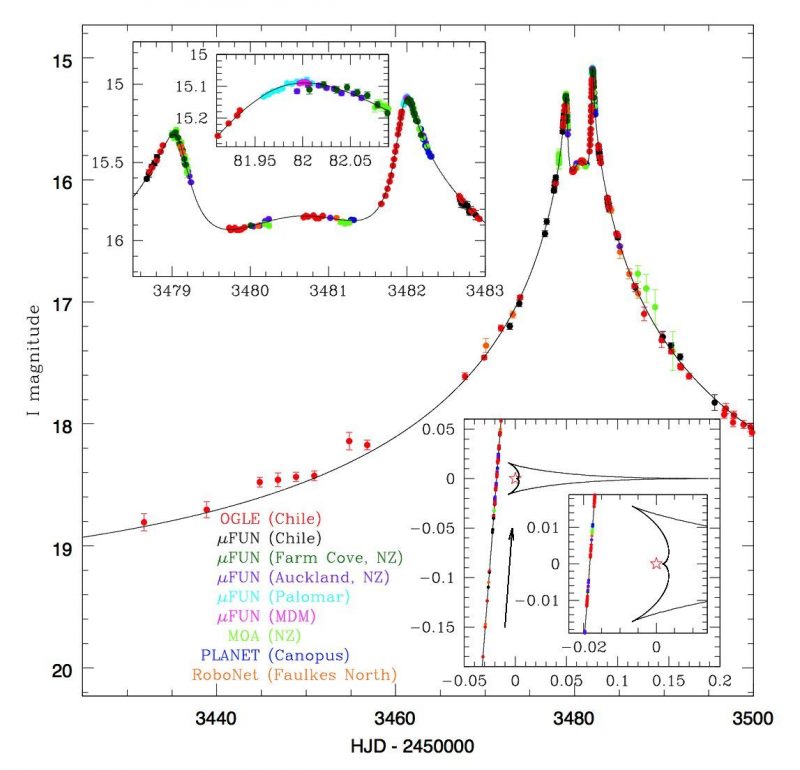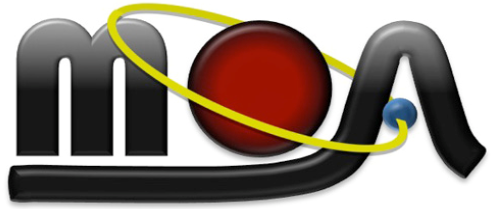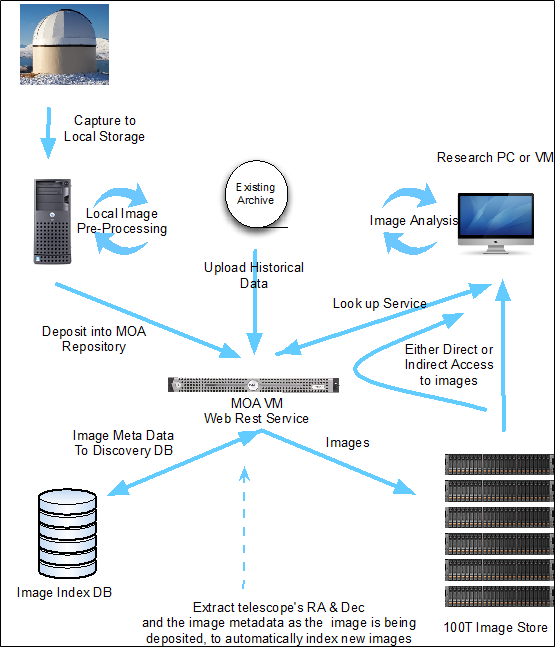
Data management planning for MOA*
*Microlensing Observations in Astrophysics (MOA)
Dr Nicholas Rattenbury, Physics, University of Auckland; Associate Professor Ian Bond, Institute of Natural & Mathematical Sciences, Massey. Research data management designed by Rob Burrowes, Data Lead, Centre for eResearch, University of Auckland
The background
MOA is a Japanese New Zealand collaboration that makes observations on dark matter, extra-solar planets and stellar atmospheres using the gravitational microlensing technique. The phenomenon now known as gravitational microlensing was first described by Einstein in 1936 in a paper on the lens-like action of a star by the deviation of light in the gravitational field (Science, Vol.84, P.506). The phenomenon enables a distant star to be effectively magnified by the gravitational field of a nearer collinear star. The magnification is given by the ratio of the area of the Einstein ring to the area of the source star. It may reach values as high as 1,000. As noted by Einstein, the alignments that are needed to observe the effect are rare. Moreover, as all stars are in motion, they are brief and non-repeating. In typical examples, magnification is detectable over a period of about one month. Most examples of gravitational microlensing are observed in the dense stellar fields in the galactic bulge, as illustrated in Figure 1.

Figure 1. Formation of an Einstein ring when two stars are collinear as seen from Earth. In this case a solar-like star is being lensed by a red dwarf. The radius of the Einstein ring is typically about 2 AU. The angular width of the ring is equal to the angular radius of the source star (S. Liebes, Physical Review, Vol. B133, p. 835).

Figure 1. High magnification event OGLE 2005-BLG-71 shows clear evidence of a planetary perturbation. Data were obtained by several telescopes around the globe, including amateur astronomers in New Zealand, but sufficient data to characterise the planet were obtained by Andrzej Udalski alone using the OGLE telescope in Chile. See astro-ph/0505451 for details.

How we work with MOA to build a data management plan and repository
The Centre for eResearch is working with Dr Nicholas Rattenbury and Associate Professor Ian Bond to create a searchable image repository to facilitate future research. The repository will enable easy access to images of stars of interest, allowing researchers to be able to quickly determine if currently observed events have repeated in the past. The repository will also facilitate new research into machine learning algorithms, that will data mine the images in the repository in search of previously unknown events. See the data management diagram 1.
* Microlensing Observations in Astrophysics (MOA)

Diagram 1. Data management flow.
See more case study projects

Our Voices: using innovative techniques to collect, analyse and amplify the lived experiences of young people in Aotearoa

Painting the brain: multiplexed tissue labelling of human brain tissue to facilitate discoveries in neuroanatomy

Detecting anomalous matches in professional sports: a novel approach using advanced anomaly detection techniques

Benefits of linking routine medical records to the GUiNZ longitudinal birth cohort: Childhood injury predictors

Using a virtual machine-based machine learning algorithm to obtain comprehensive behavioural information in an in vivo Alzheimer’s disease model

Mapping livability: the “15-minute city” concept for car-dependent districts in Auckland, New Zealand

Travelling Heads – Measuring Reproducibility and Repeatability of Magnetic Resonance Imaging in Dementia

Novel Subject-Specific Method of Visualising Group Differences from Multiple DTI Metrics without Averaging

Re-assess urban spaces under COVID-19 impact: sensing Auckland social ‘hotspots’ with mobile location data

Aotearoa New Zealand’s changing coastline – Resilience to Nature’s Challenges (National Science Challenge)

Proteins under a computational microscope: designing in-silico strategies to understand and develop molecular functionalities in Life Sciences and Engineering

Coastal image classification and nalysis based on convolutional neural betworks and pattern recognition

Determinants of translation efficiency in the evolutionarily-divergent protist Trichomonas vaginalis

Measuring impact of entrepreneurship activities on students’ mindset, capabilities and entrepreneurial intentions

Using Zebra Finch data and deep learning classification to identify individual bird calls from audio recordings

Automated measurement of intracranial cerebrospinal fluid volume and outcome after endovascular thrombectomy for ischemic stroke

Using simple models to explore complex dynamics: A case study of macomona liliana (wedge-shell) and nutrient variations

Fully coupled thermo-hydro-mechanical modelling of permeability enhancement by the finite element method

Modelling dual reflux pressure swing adsorption (DR-PSA) units for gas separation in natural gas processing

Molecular phylogenetics uses genetic data to reconstruct the evolutionary history of individuals, populations or species

Wandering around the molecular landscape: embracing virtual reality as a research showcasing outreach and teaching tool
























































































































































